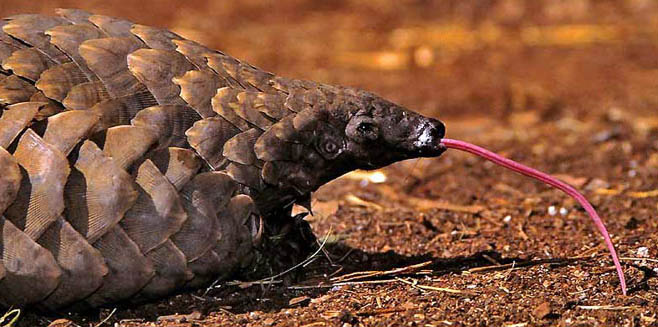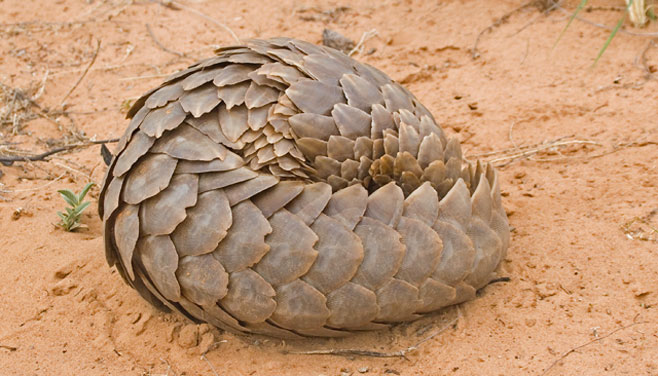|
Manis temminckii (Ground pangolin)
Cape pangolin, scaly anteater, Temminck's pangolin [English]; ietermagog
[Afrikaans]; Steppenschuppentier [German]; pangolin de Temminck [French];
kakakuona [Swahili]; inkakha [isiNdebele]; kgaga [Sepedi] [Sesotho] [Setswana];
haka, hambakubvu [Shona]; imfinyezi [siSwati]; xikwaru [Xitsonga]; khwara [Tshivenda];
nake [Lozi]; unkaka [Yei]; || Khommi [Nama]
[Damara]
Life
>
Eukaryotes >
Opisthokonta >
Metazoa (animals) > Bilateria > Deuterostomia >
Chordata > Craniata > Vertebrata (vertebrates) >
Gnathostomata (jawed vertebrates) > Teleostomi (teleost
fish) > Osteichthyes (bony fish) > Class:
Sarcopterygii (lobe-finned fish) > Stegocephalia
(terrestrial vertebrates) > Reptiliomorpha > Amniota >
Synapsida (mammal-like reptiles) > Therapsida > Theriodontia
> Cynodontia > Mammalia (mammals)
> Placentalia (placental mammals) > Laurasiatheria
> Ferungulata > Ferae
 |
|
Ground pangolin, Photographed in captivity in
Johannesburg, Gauteng Province, South Africa. [photo Callie de Wet ©] |
 |
|
Ground pangolin, near Hotazel, Northern Cape,
South Africa. [photo
Neil Gray
©] |
Identification
The pangolin cannot be mistaken for any other animal with
its horny covering of overlapping scales on the head, body, outer surface of the
limbs and the tail. The brown scales consist of agglutinated hair and are shaped
like artichoke leaves. They grow from the thick underlying skin and are shed and
replaced periodically. Smaller scales occur on the limbs and the top of the
head. The underparts of the animal are sparely covered with hair. The pangolin
has an elongated tapered body shape with a small, pointed head. The short
forelimbs are short and the hindlimbs are large and powerful. The tail is long
and heavy.
The large digging claws tucked up under the forefeet makes
the pangolin walk slowly on the outer edges of their feet with a shuffling gait.
They can move more swiftly by running on their hindlegs using the tail and
forelimbs for balance
Size
Body Length 70-100 cm; weight range 5 – 15 kg
Distribution and habitat
Widely distributed is southern African subregion
north of the Orange River. Occurs in open grassland, woodland, and rocky hills,
in both high and low rainfall areas.
General behaviour
When threatened or alarmed the pangolin may run away or my
roll itself into a tight ball with its scales as protective shield for its head
and underparts.
Pangolins are solitary, and usually nocturnal with
occasional daytime activity. They may excavate their own burrows but often use
the burrows of other animals (e.g. springhare or aardvark) or simply curl up in
dense vegetation or leaf litter.
Food
Pangolins are specialized to eat only ants and termites.
Their very long narrow sticky tongues are specifically adapted for probing into
ant and termite nests. The tongue is connected at its base to a posterior
extension of the sternum. A sticky viscous saliva is secreted onto the tongue by
a large salivary gland situated in the chest cavity. Their skull has not teeth
or any chewing muscles. They have a specially adapted gizzard-like stomach that
grinds up the ants. They use their powerful claws to break into ant and termite
mounds. Special muscles close the nostrils while feeding and the thick eyelids
protect the eyes from the ants.
Predators, parasites and commensals
Few natural predators, only hyaena and lion are able to
penetrate the scale defense.
Reproduction
After a gestation period of about 139 days, a single young
is born underground in a burrow that may be
several metres deep. At birth their scales are small and soft. They are first
taken outside riding on their mother’s tail at 2 – 4 weeks. If the mother is
alarmed she will often curl up encircling her baby. Life span: 13 years (in
captivity).
Conservation
Pangolins are victims of the bushmeat
trade and their scales are used as traditional medicine. Conservation status is
classed as Lower risk, near threatened.
Text by Denise Hamerton
|
